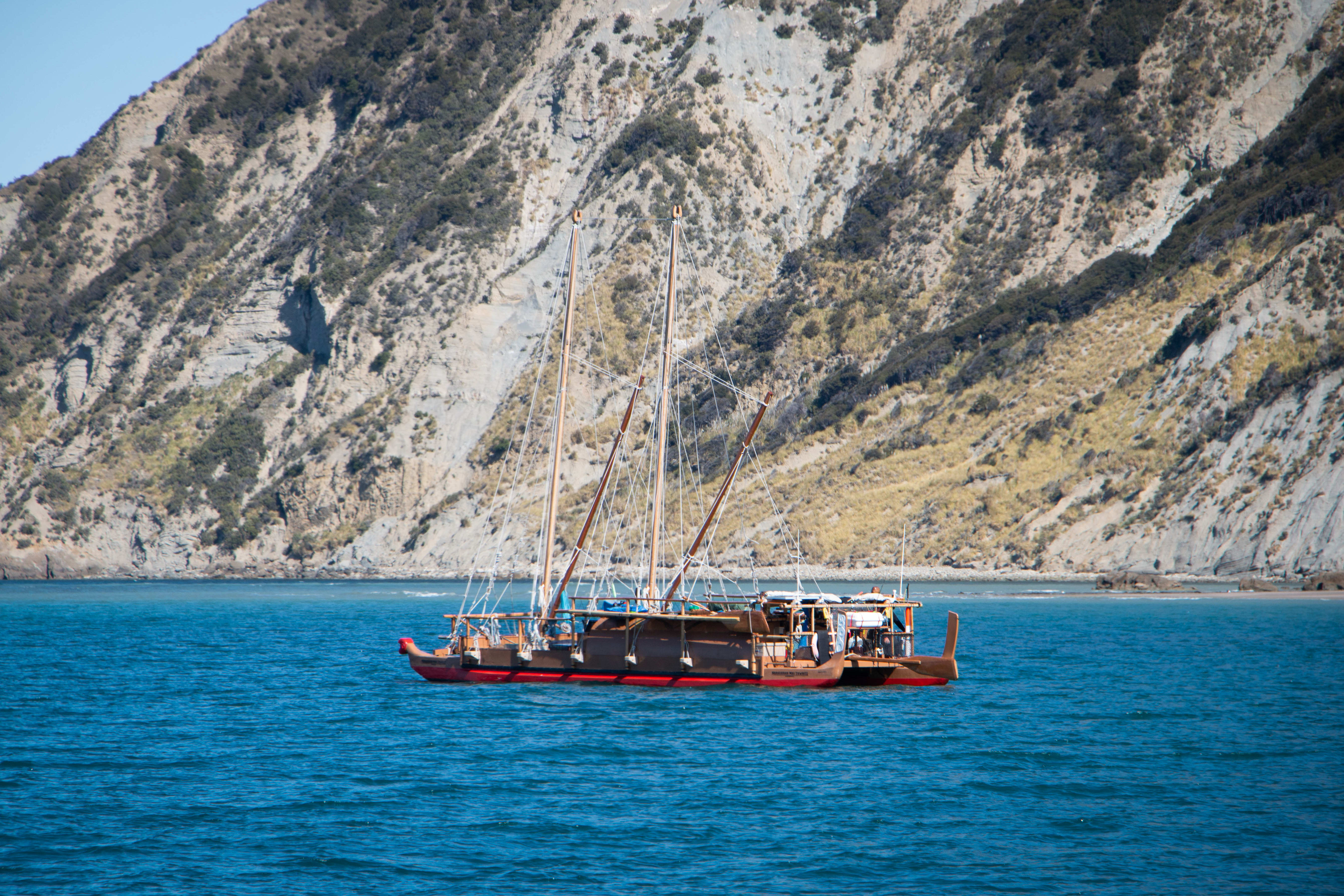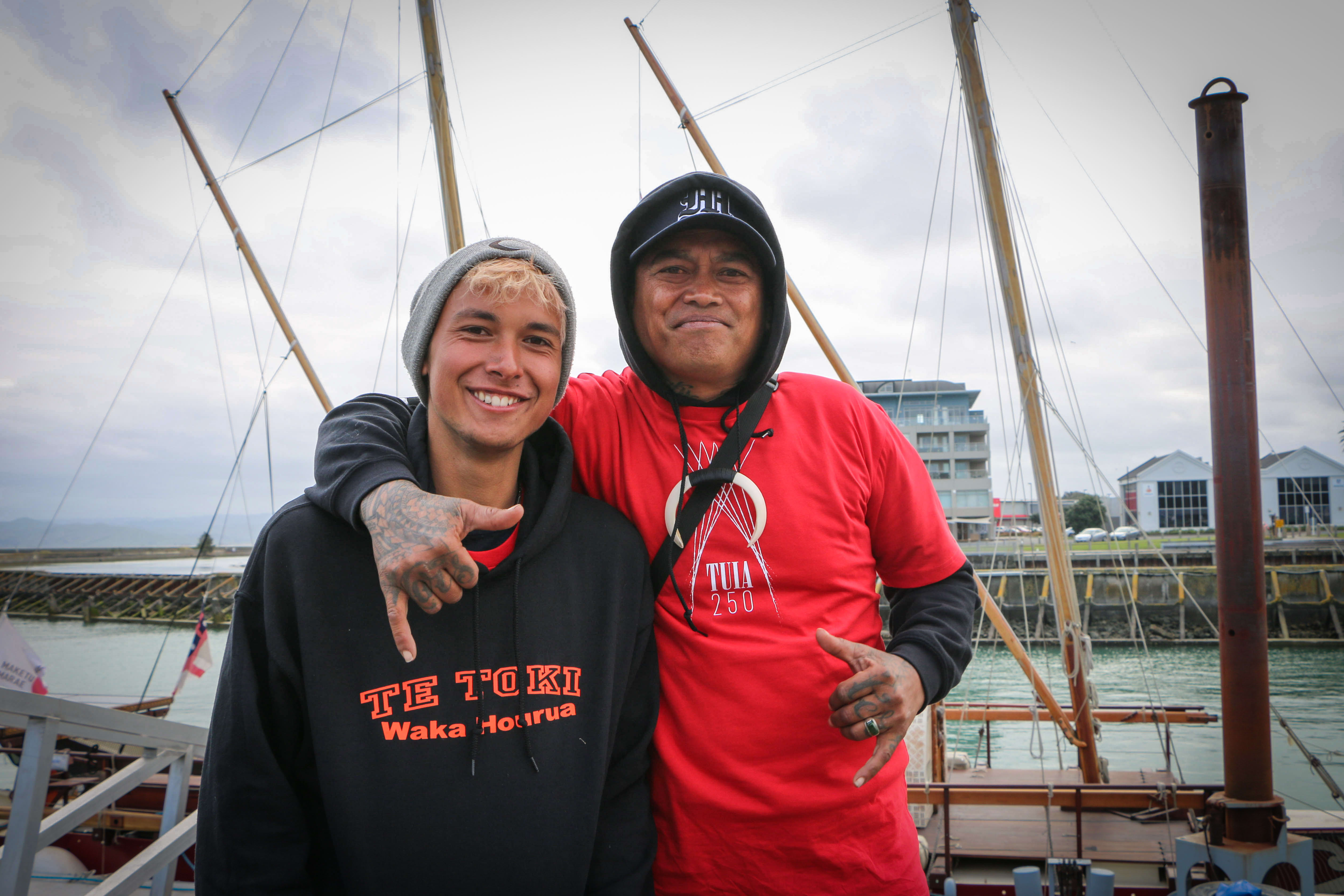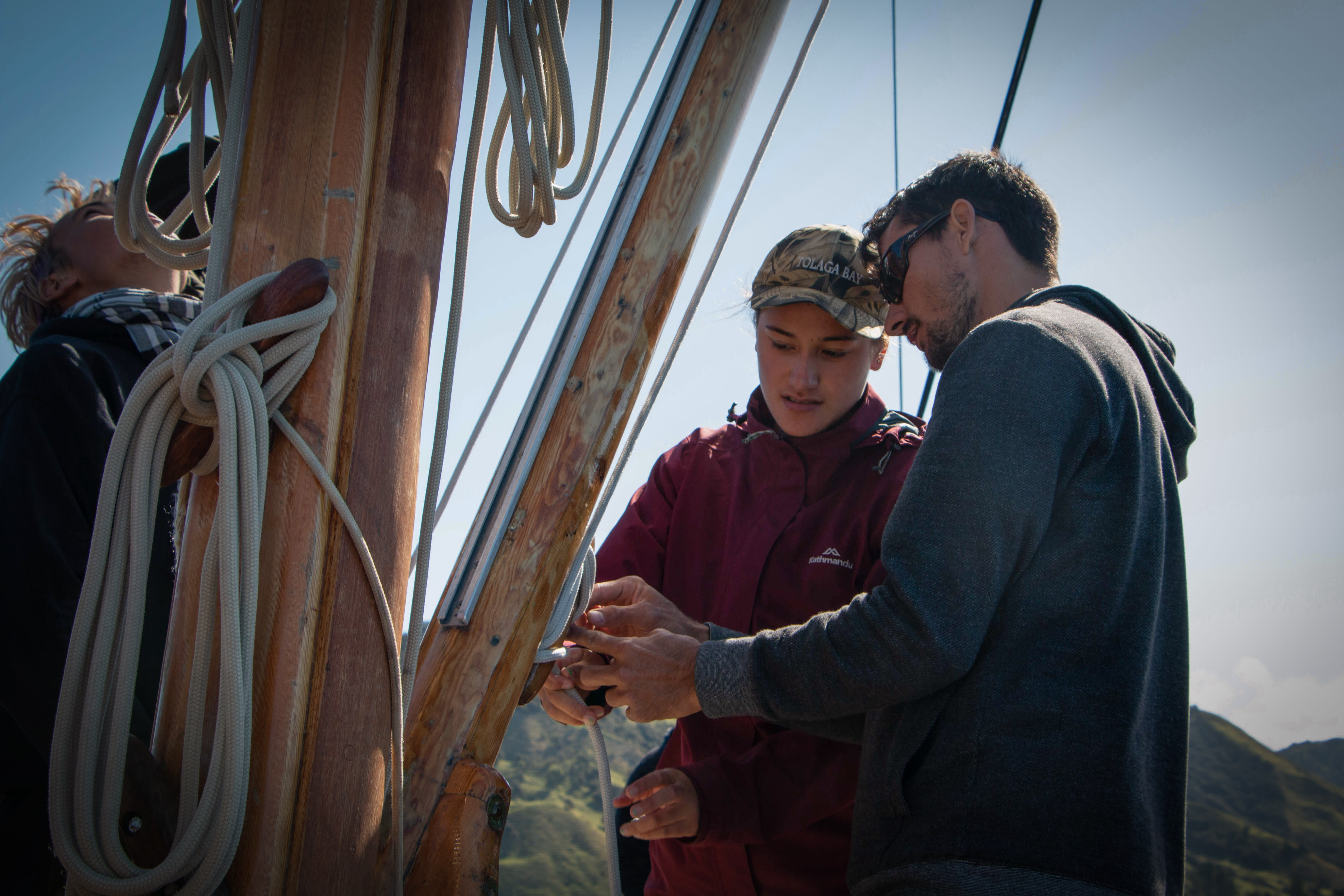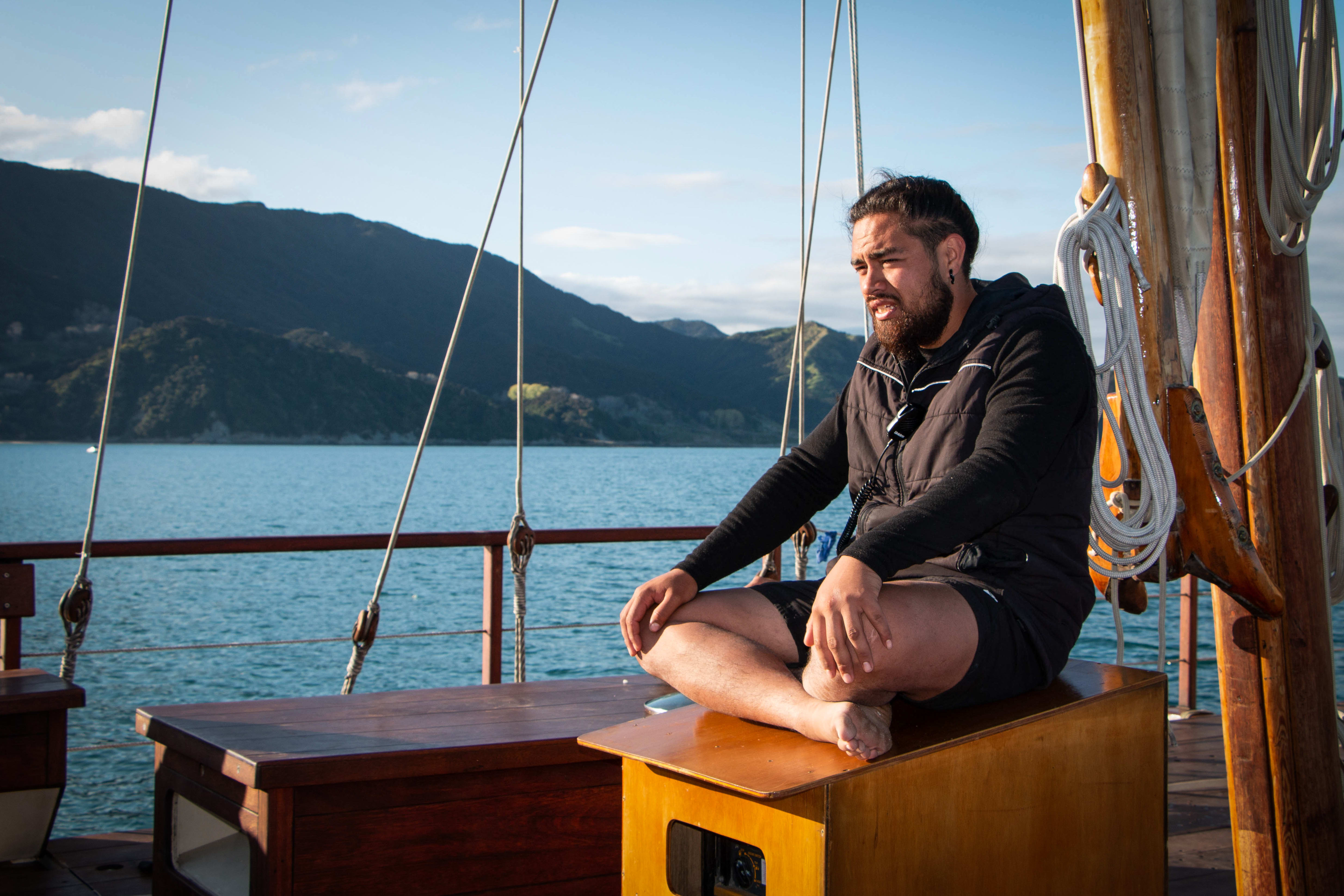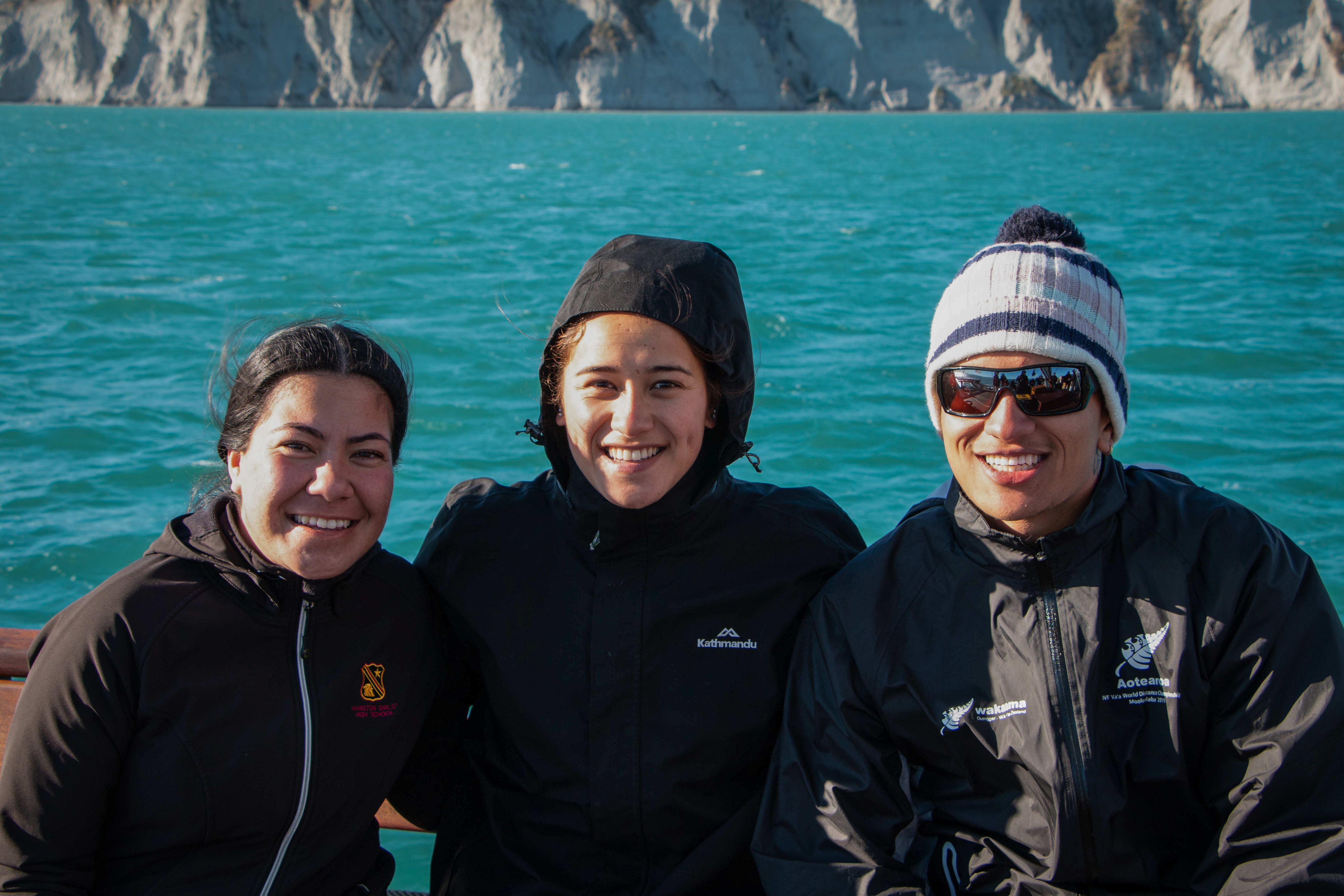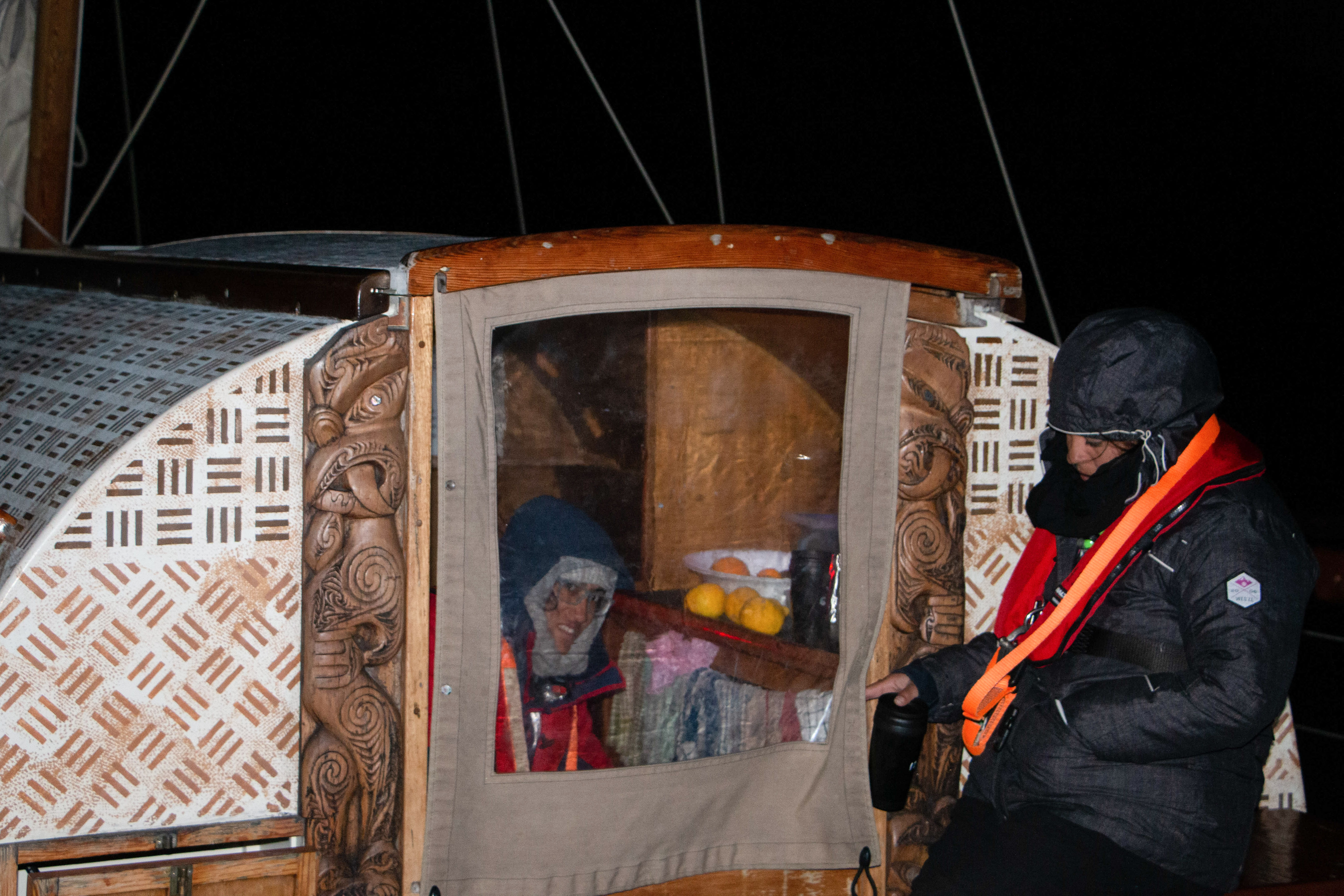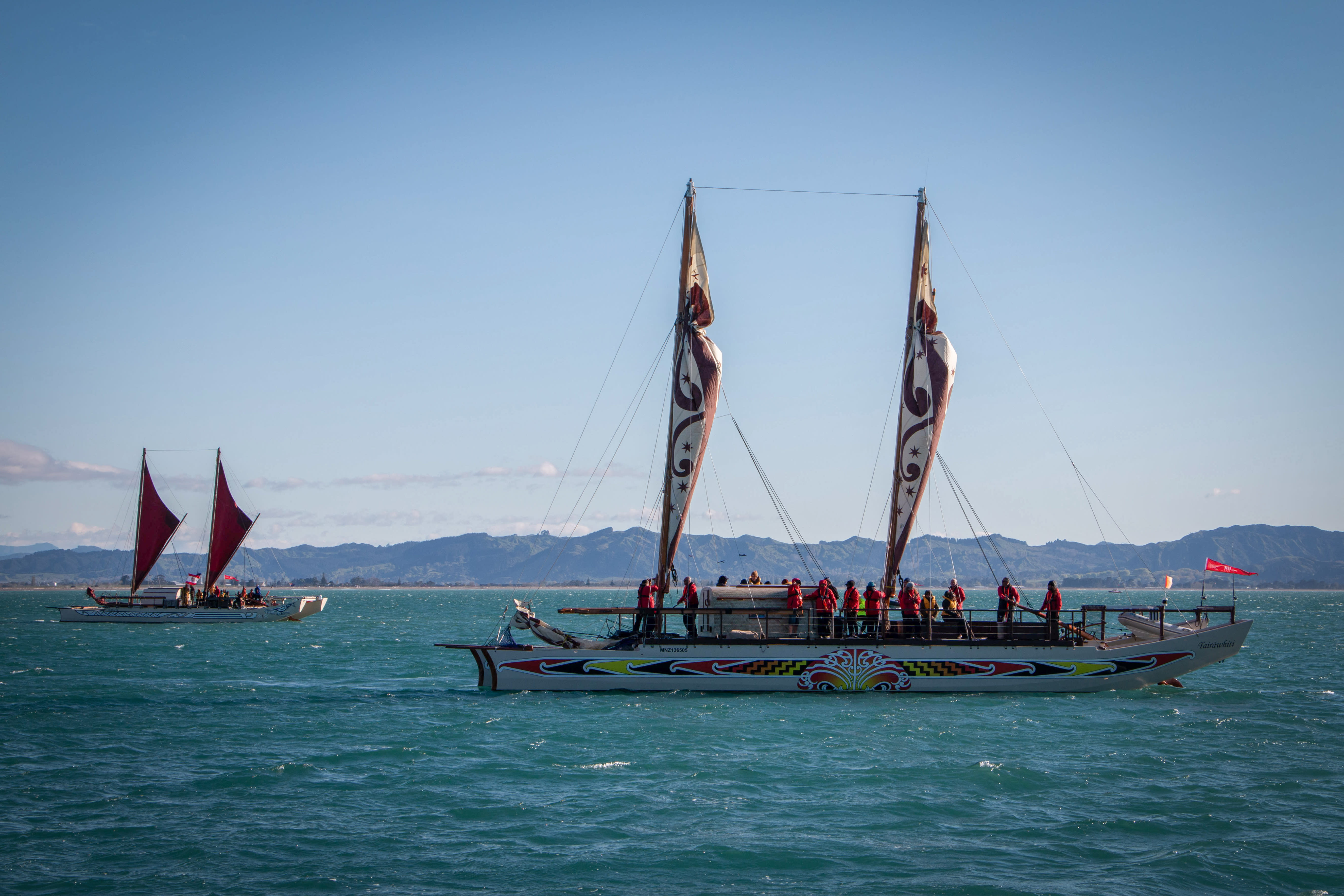Guided only by the stars and the Moon like our first Polynesian navigators over 750 years ago, Meriana Johnsen joins the crew onboard Haunui waka, on an overnight haerenga from Anaura Bay to Gisborne, as the waka flotilla makes its way around Aotearoa for the Tuia 250 commemorations.
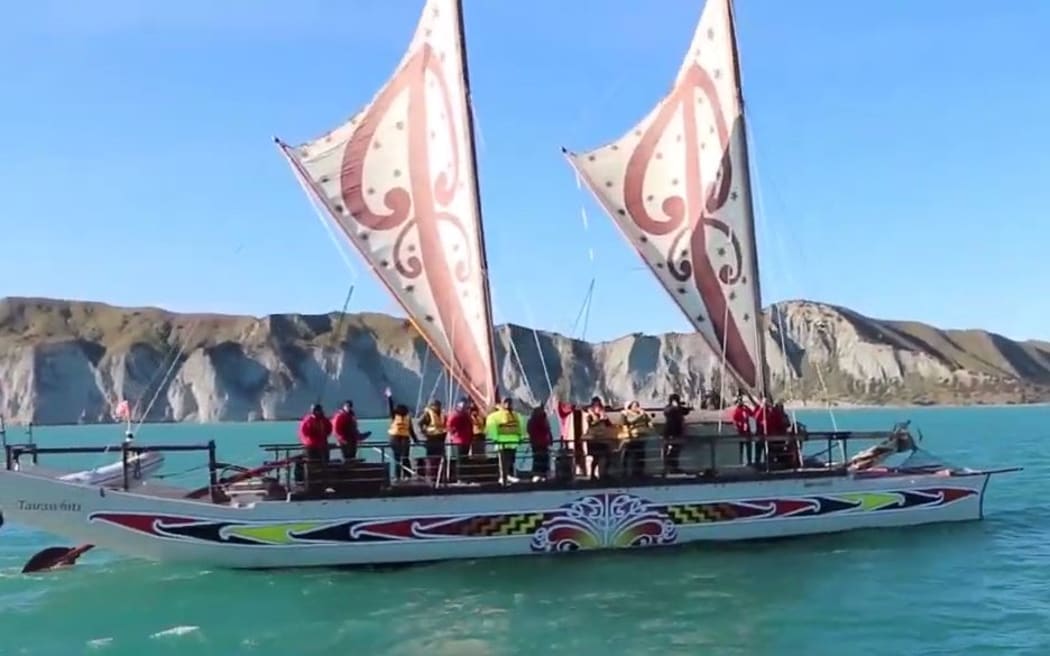
Photo: Supplied
Black ropes are flinging wildly in the wind; the head sail has been let out and crew members are rushing to secure it. I watch as the sail billows overhead. Nohorua Ropata and Kahurangi Ngata are jumping up to grab the ropes. When they've latched on, they hold them down using all their body weight.
We are in the middle of tacking up and it is quick, physical work. Kahu has a huge welt on his left wrist from where he was stung trying to secure the head sail; Manaakiao Maxwell has blood on his fingers and my hands are red and raw from pulling the sheetline in. But no-one is complaining - this is waka life where it is all hands on deck and you're spurred on by the rush of the wind, which has us constantly on our toes. The captain reads every shift in its direction and strength, and we are pulling, letting out and tying down ropes at his every command.
We're on the waka Haunui, sailing from Anaura Bay to Tūranganui-a-Kiwa as part of the Tuia 250 commemorations. This is the first time the story of how Māori came to arrive in Aotearoa has been shared alongside that of Cook's arrival on these shores in 1769 and we are sailing on the same type of waka our Polynesian ancestors used to sail the Pacific ocean.
Haunui is a replica of a traditional double hulled voyaging canoe, a waka hourua.It was originally built in 2009 for American Samoa and given the name Va'atele. But on its maiden voyage it was damaged when a tsunami hit the island. It was left tied to the pier in Samoa, until Hoturoa Kerr, the founder of Te Toki Voyaging Trust, said he would take care of it.
Its name comes from the famous orator of Waikato Tainui, John Haunui, who died a week before the ceremonial process for the waka.
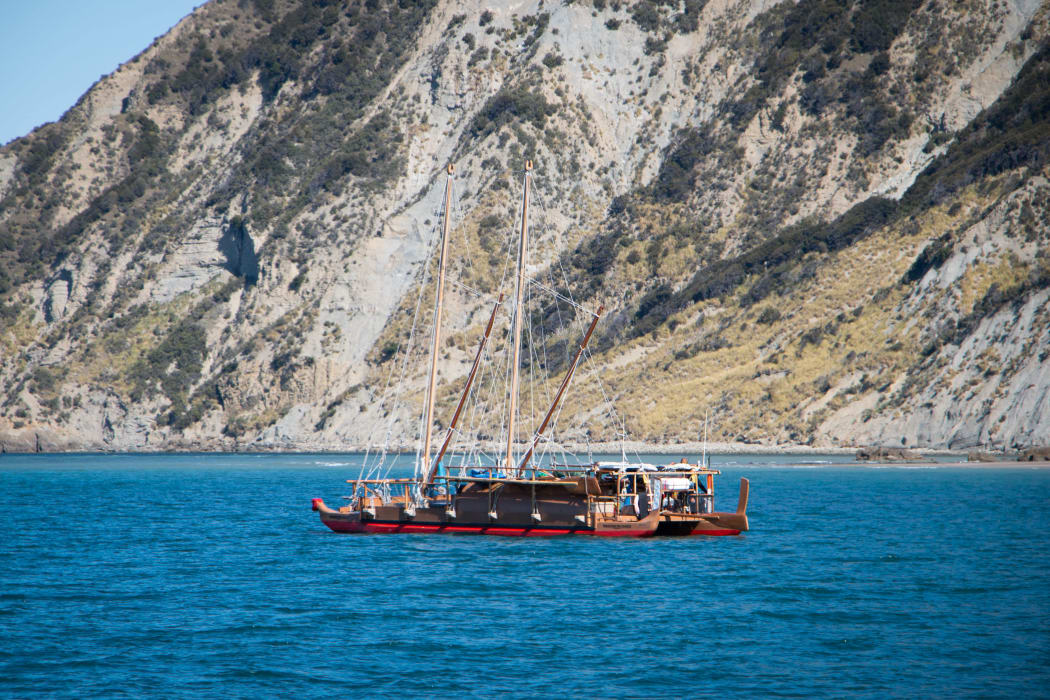
Ngahiraka Mai Tawhiti anchored in Anaura Bay ahead of the overnight sail to Taranganui-a-Kiwa. Photo: RNZ / Meriana Johnsen
A waka is not just a boat. It is a living being, and is therefore treated as such. Parts of the waka are named after tīpuna, or ancestors: the port side is named after the white heron, Pikikotuku, and the starboard or the right side, is the house of the albatross, Wharetoroa. The hoe is the knowledge centre, or the foaming house of the sea, Te Wharehukahuka o Tangaroa.
We have 12 crew members onboard our leg from Anaura Bay to Gisborne, led by our captain John-Reid Willison.
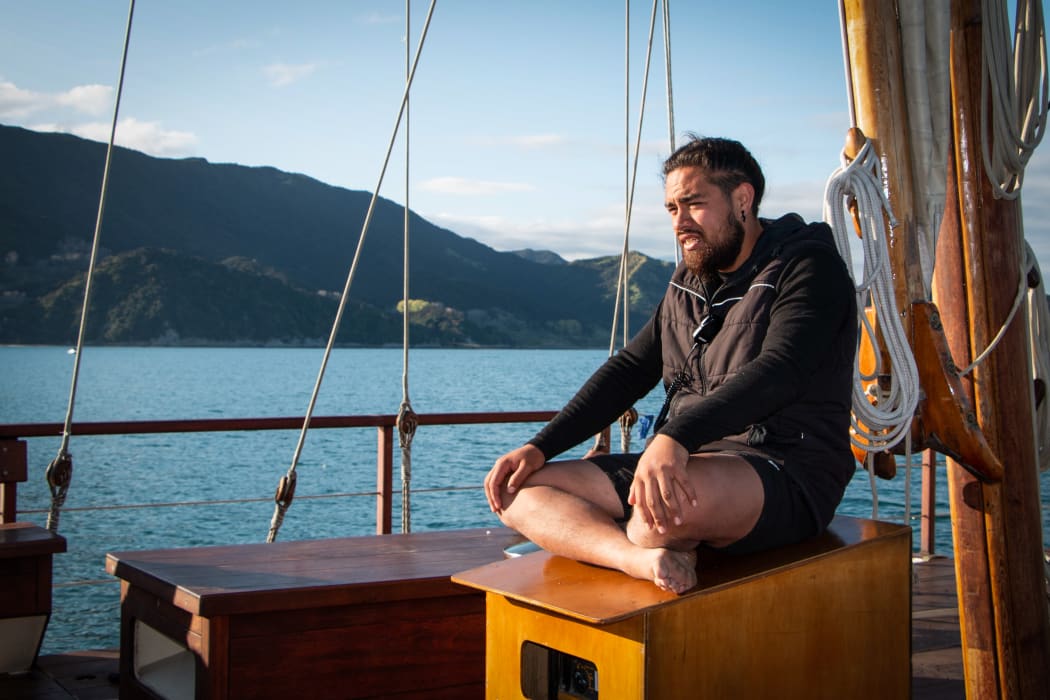
Captain John Reid briefs the crew ahead of the overnight sail to Gisborne. Photo: RNZ / Meriana Johnsen
Before we set sail on our voyage, we are divided into two watch groups. On my watch, there's two trainees, myself and 16-year-old Manaakiao from Gisborne, who has an incredible singing voice, and who keeps everyone entertained in the bittercold at 3am with an endless stream of waiata. There's Noe, whose always cracking jokes about being Beyonce, and who often loses her stuff. Next, we have Pāpā Tony Marsters, the oldest of the crew, who is always looking out for the rest of the crew, but especially the trainees.
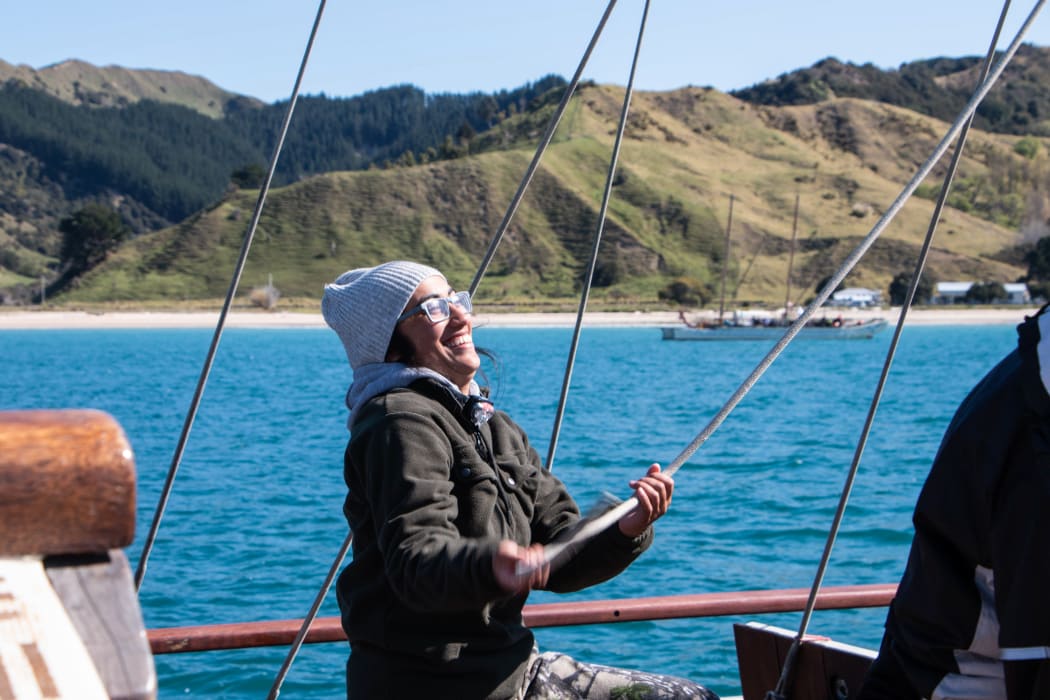
Noenoe Barclay-Kerr helps to set sail. Photo: RNZ / Meriana Johnsen
There's Zaza Eden Haoa-Bellais from Tahiti, quiet, with a long stare that stretches as far as the open sea. Finally there's our watch captain 17-year-old Nohorua Ropata from Porirua, who, no matter the weather, even at 3am in the freezing cold, is always barefoot.
The four trainees - Manaakiao, Arie Tiniwhetu Dargaville Rehua, Ariata Kutia and myself - are given the rundown on where everything is.
We're shown the three-step process of using the toilet: foot on the lid, little finger over the valve and pump gently 10 times. We're taught the commands we'll need to know when we're out sailing: Port, Starboard, Mizen, Main. We're shown how to do a bowline and how to "tie off", or secure a rope to a cleet so that the mast, and sail stay in position.
There's no one official language spoken on the waka. Instead, there's a mixture of Tāhitian, Māori, and English, often all in one sentence. This constant cross-cultural dialogue is like the weaving of our haerenga across the choppy waters, under the korowai of our rangatira Haunui - no longer as individuals, but as one.
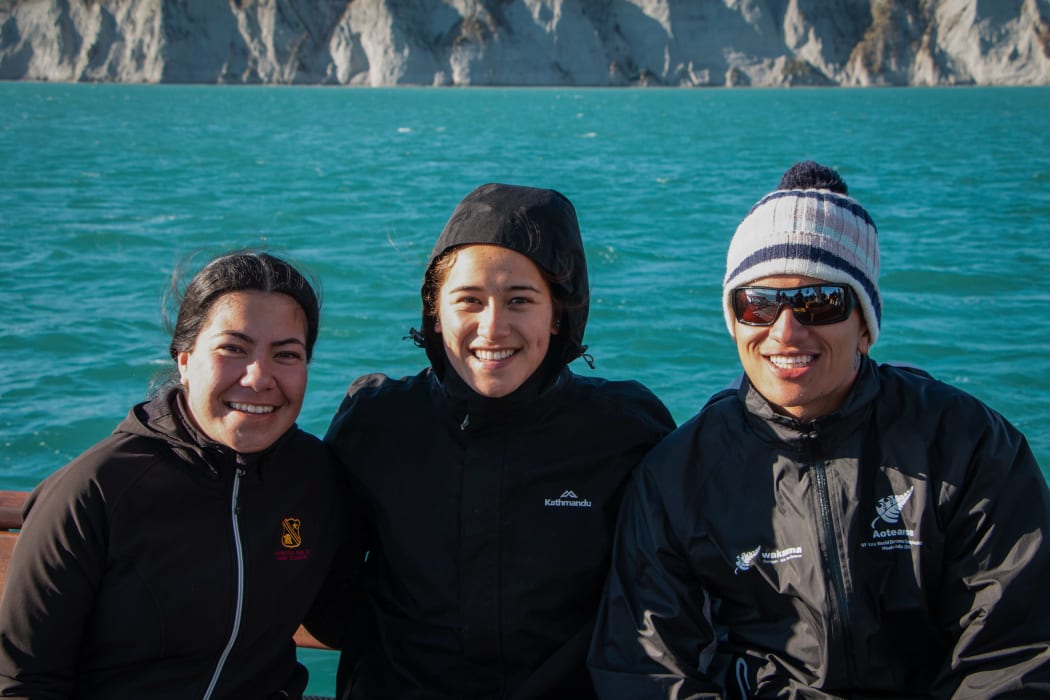
Three of the trainees, from left, Ariata Kutia, Manaakiao Maxwell and Arie Tiniwhetu Dargaville Rehua. Photo: RNZ / Meriana Johnsen
Soon after we sail off, another experienced crew member, Kahu gets out his watercolours and begins painting. In less than 10 minutes, he has painted a perfect replica of the carved head of the hoe, Wharehukahuka o Tangaroa.
He reluctantly shows me some of his other paintings - he's not the boasting type - which include stunning watercolour paintings of cliff faces. This is his way of remembering his journey as he sails around Aotearoa and the Pacific, which he plans to do for the foreseeable future.
The sun is setting in the hollow of two peaks, coming to rest behind the looming cliff faces that zig-zag along the coast. We leave behind the bowl of Anaura Bay where our waka have been quietly nestled, and head out to brace the whims of Tāwhirimātea, the God of wind, who likes to wind up his brother Tangaroa, the God of the sea.
The moment we hit open waters, my sea legs weaken. I can barely touch my dinner and Pāpā Tony suggests that I don't bother trying to stomach it. He's been through his fair share of sea sickness, and tells me to avoid coffee.
Someone fetches me a sea sickness pill and I lie down until my watch at 9pm. It is strange lying in the hull of the canoe on my tiny bed, wearing what feels like every layer of clothing I packed, without my cellphone or laptop, which we had to hand over at the beginning. My mind is free to roam, and I find myself crawling into alcoves of thought.
"You're really connecting with taiao, with the people onboard, [and] you're disconnecting, I should say, from everything on land," is how Noenoe Barclay-Kerr describes being out at sea.
"You're disconnecting yourself from all the stress and the struggle on the whenua and you're regathering yourself to be able to handle it when you're back on land."
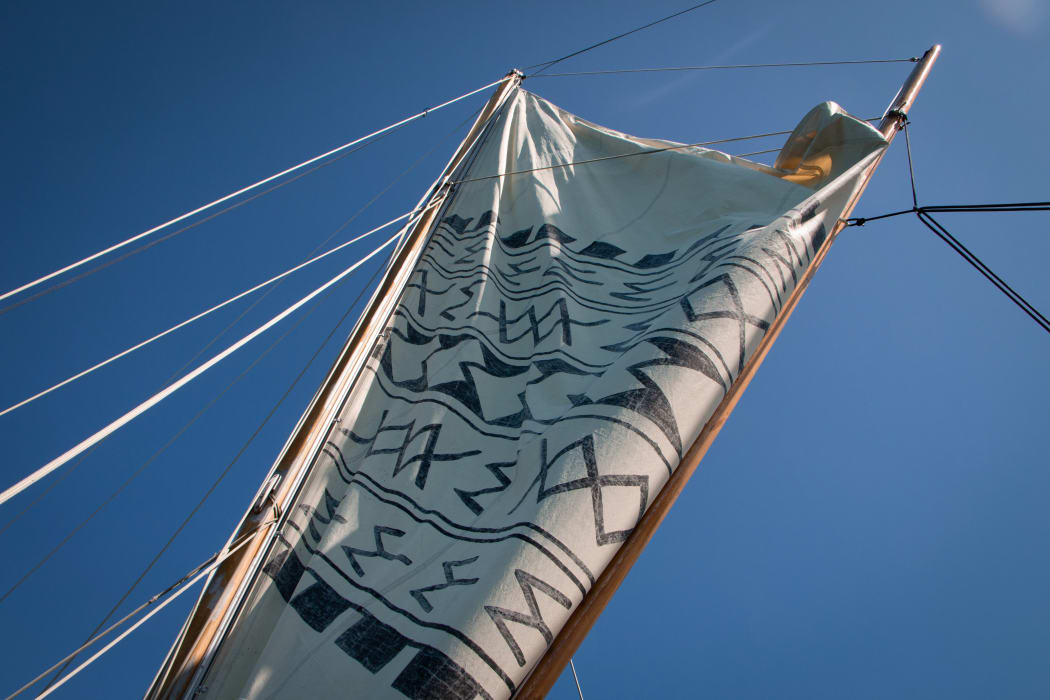
Setting sail. Photo: RNZ / Meriana Johnsen
When I finally emerge from the hull, my watch crew are already on deck for our 9pm - 12am shift. Pāpā Tony suggests I have a turn holding onto the large wooden hoe, which acts as a rudder for the boat.
The hoe is beautifully carved, and when you hold it you can feel every shift of the currents and surge of the ocean in your bare hands. I cling on to it, planting my feet as firmly into the waka as I can, while clutching the end of the hoe.
We're instructed by the captain to move the hoe so that the Moon remains positioned just above where two ropes cross over. This is our compass point. Pāpā Tony, who supports me with the hoe, tells me that during his 19-day journey to Rarotonga, the waves were sometimes taller than the masts, and they would have five people on the hoe.
"If anyone wants to get a fraction of what our tūpuna did, they would feel that on the hoe. When you have to pick a mark and you've got to follow that mark on your waka you can feel the same kind of experience that our ancestors did, doing it by stars, the Moon... this is how our ancestors travelled and you start to connect, you start to tap into that," he says.
"For me it's very spiritual and very personal, so when it comes to that, you tend to learn a lot about the waka, which is where we're all from."
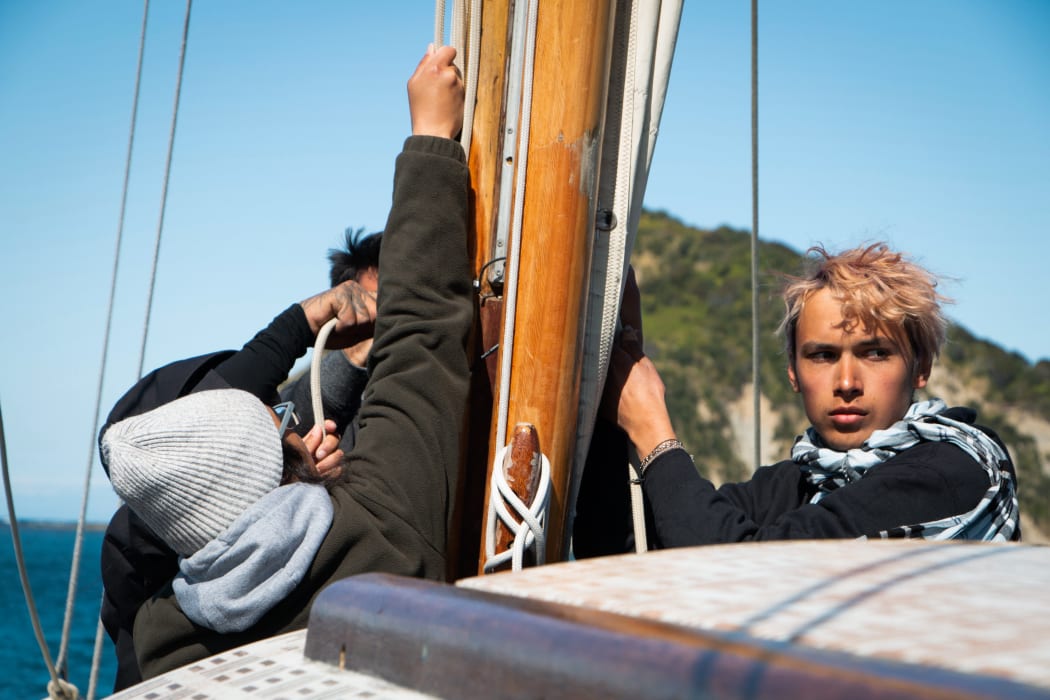
Crew members respond to the captain's instructions. Photo: RNZ / Meriana Johnsen
Pāpā Tony, or Tony Upu-Marsters, gave up his job and life for the waka. He had never stepped on a waka hourua before he took the Auckland to Rarotonga trip earlier this year.
"I didn't know that much about where I was from and what we did. I never knew that we were great mathematicians, we were great astrologists, we were great engineers, and it wasn't until I got on to the waka that I was taught all these things which was really fulfilling for me."
"We're all good at what we do as we get older, we work hard, and sometimes we work hard for materialistic things and for me, [this] was all about working hard for getting mana, and building something that I never thought I had.
When he gives talks at schools about life on the waka, he tells the kids the hardest part is being away from your loved ones.
"It wasn't doing the mahi on the waka, mahi is nothing - it's all part of what we do - it was absolutely my loved ones that I found hard. I just missed them dearly."
The watch goes by quickly. We keep ourselves awake and warm by singing every waiata we can think of, from Toia Mai to Hometown Glory by Adele. Manaakiao even makes up a few melodies and lines of his own. Before we know it, the next watch are up and ready to go and it's time for us to get a few hours sleep.
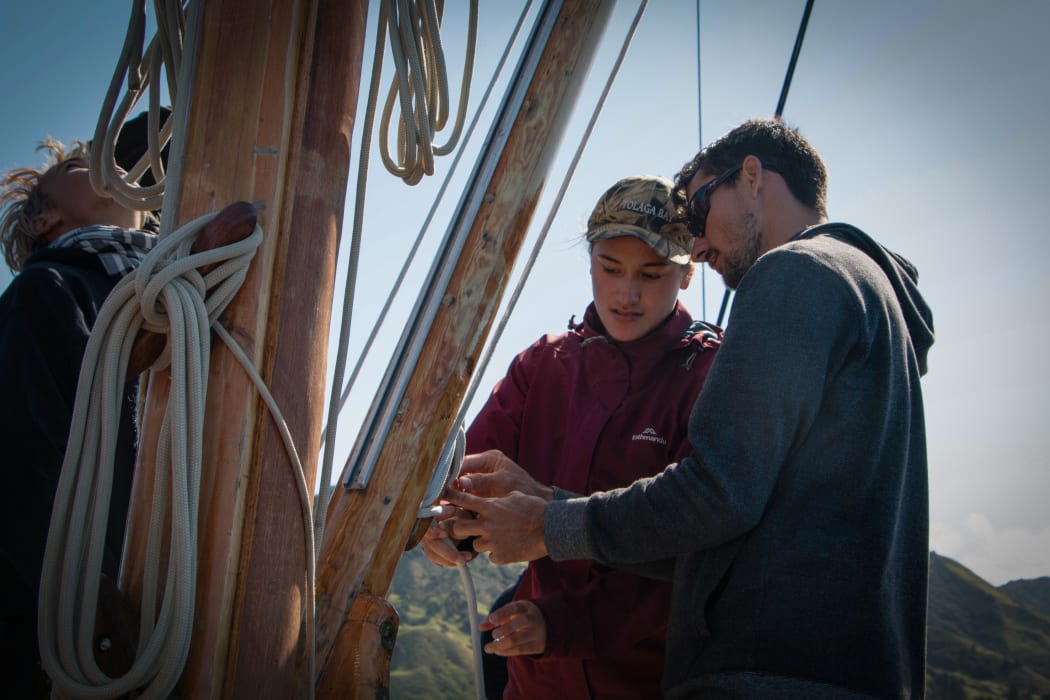
A crew member shows a trainee how to lock on. Photo: RNZ / Meriana Johnsen
"Hey, time to wake up for your watch."
I slowly come to through a heavy haze as my eyes adjust to an illuminated face above me. There's water sloshing against the walls and they are freezing cold to touch. But these aren't walls at all. It is 3am and I am in the hull of a canoe. The light disappears and I lie in the darkness for a moment, letting myself be lulled back to sleep by the gentle to-and-fro.
"You guys awake?" The light is back. There's no time to sleep-in. The first watch has finished and it is our turn to keep an eye over the waka. I drag myself out of bed and pull on my wet weather gear. Climbing up the stairs and through the hatch, I am fully woken by the roar of the wind in my ears. The stars stretch long and wide above me. This is our map, unfurled across the night sky.
It takes some time for our eyes to adjust and we're encouraged not to use our headlamps, or if we have to, the red light so it is easier on everyone. The wind whips around us, but we're closer to shore - you can faintly see the outline of the cliff faces. We're told that our job is to ensure the boat stays anchored in place.
Pāpā Tony tells me to find some points on land or in the sky so we can tell if the boat has moved. I choose Māhutonga (the Southern Cross), which is dead centre between the two flags at the back end of the waka, and the two stars in a line below them - Uruao and Ranginui.
This is my job for the next few hours. Life on the water follows its own rhythm: 3 hours on, 3 hours off. Roll to the left, roll to the right. Waves rise and waves fall.
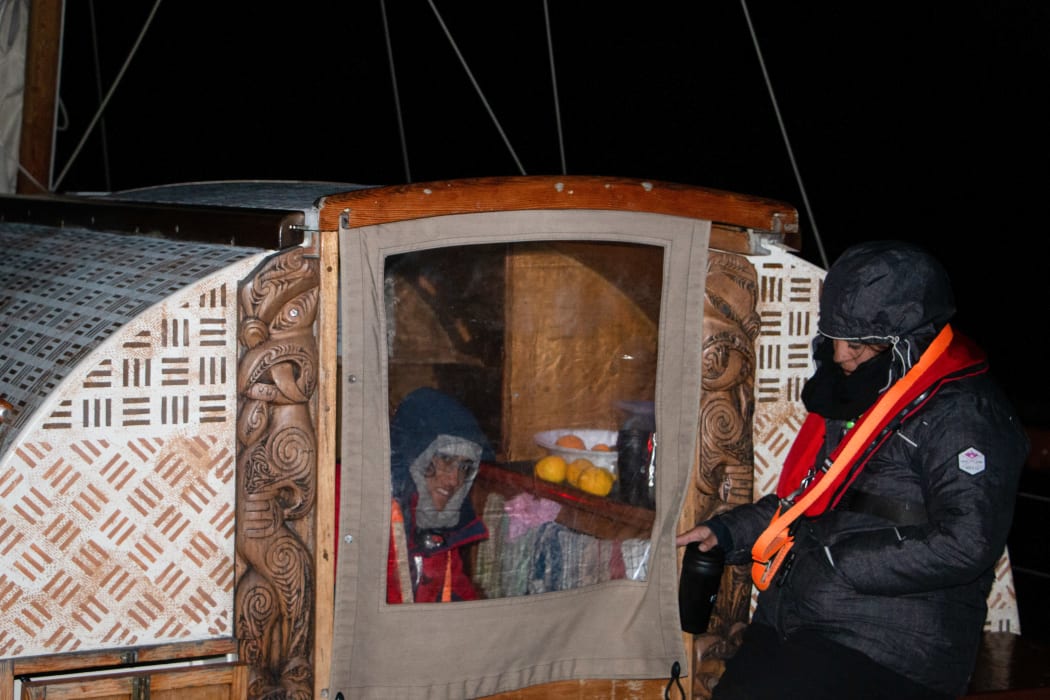
Making a cup of tea at 4am. Photo: RNZ / Meriana Johnsen
The sun has arrived over the horizon. All hands are on deck again, as we prepare to move from where we're anchored to make our grand appearance in Tūranganui-a-Kiwa.
We trace the edges of the bay, sailing past Te Kurī-a-Pāoa - the headlands which greet you at the bay's entrance.
We make our way around the bay, waving and blowing the pūtātara (shell trumpet) to the other waka crews, weaving in between, and around us, as we dance on water.
We've finally made our way into the inner harbour, 24 hours after we first left land in Anaura Bay, our hands a little rawer, and our faces a little redder. We are greeted by thousands of people waiting on shore for the arrival of the waka flotilla.
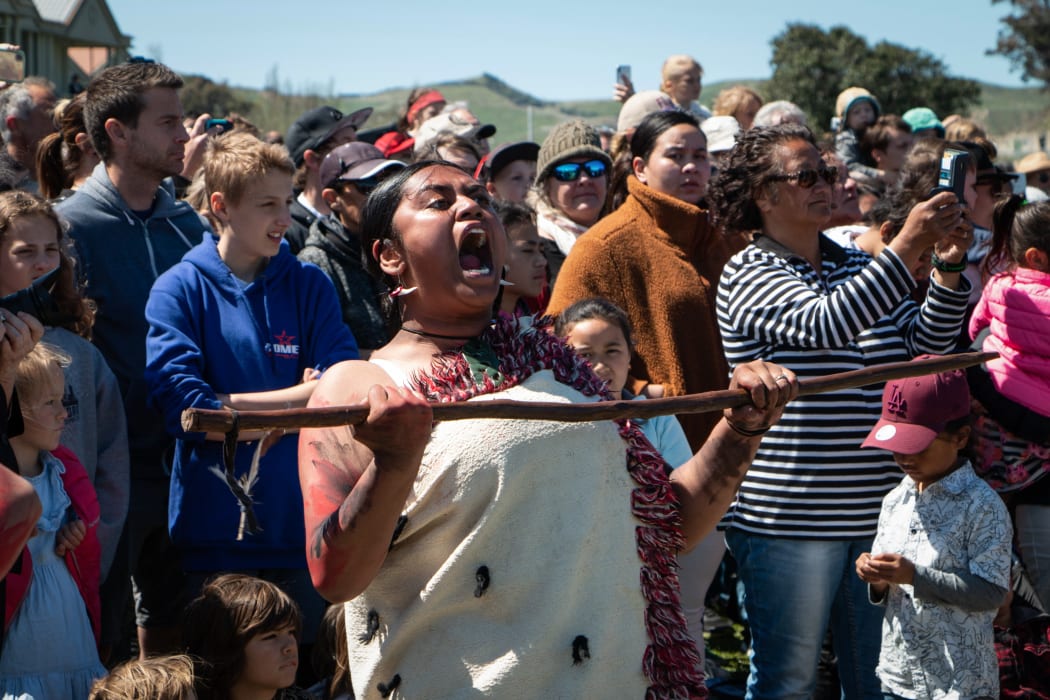
Hau kainga welcome on the waka crew at the mass powhiri in Gisborne. Photo: RNZ / Meriana Johnsen
It is on these shores that our people first landed over 750 years ago, but the scene is now much different. The totara and moa have been replaced with seas of people, winding roads and pine logs ready to be shipped across the Pacific on huge ships.
But the one thing that hasn't changed is the waka we arrive on. It is used to traversing open seas, and arriving in new lands. For our rangatira, the waka Haunui, it's business as usual.
But for us trainees, we're returning home to our whenua with the taste of Tangaroa in our mouths, Tāwhirimātea in our ears, and a renewed sense of how we came to call Aotearoa home.
